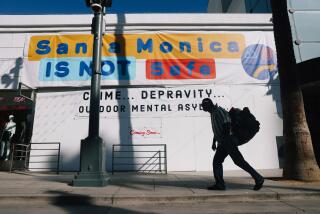Loitering Case Decision Due but Legal Questions Linger : Law enforcement: City officials claim victory in battle over drug-related ordinance. A public defender calls it vague.
- Share via
MONROVIA — The misdemeanor loitering charge against Raymond Ramirez, an Azusa felon and suspected drug dealer, may seem an unlikely constitutional issue.
But its resolution, expected Friday during a court hearing in Monrovia, ends--apparently without a clear decision--a chapter in a nearly two-year fight between the San Gabriel Valley city and the Los Angeles County Public Defender’s office.
The fight dragged Ramirez’s case through Superior Court, a state appellate court and the California Supreme Court before being sent back down to Santa Anita Municipal Court.
At issue was Monrovia’s controversial drug-related anti-loitering ordinance.
Modeled after a 1988 Tacoma, Wash., ordinance, Monrovia’s law, adopted in April, 1990, is the first in California designed to take suspected drug dealers off city streets by arresting them for loitering, Police Chief Joseph Santoro said. Constitutional challenges were expected, but Santoro said careful police training in the new law and community outreach programs have helped avoid most legal problems.
“No one has ever said, ‘Gee, you arrested an innocent person on this,’ ‘ Santoro said. “They either have marijuana or cocaine on them, or they are on probation or parole for narcotics-related crimes.”
But Deputy Public Defender John Scott, who fought against the law in court, contends that the measure is vague, over-broad and aimed at a class of people--including gang members, drug users or those who live in drug-dealing areas.
“Essentially, the ordinance allows them to arrest people that they can’t prove committed a crime,” Scott said.
Santoro and city attorneys claim victory, because the state’s higher courts refused to hear appeals on the case of Ramirez, 26, who is expected to plead guilty to a different offense Friday. But Scott contends that the measure can be contested again with another person willing to fight a loitering arrest.
“Without a (formal) court decision, the question is still completely open,” he said.
Monrovia police turned to creating the law after they were stymied by dealers brazenly peddling their drugs on some of the city’s tree-lined, residential streets.
“Why can’t police find the rock cocaine?” frustrated residents asked.
Crafty dealers swallowed the dope, smashed it underfoot or crumpled it in wads of paper, then dropped the “stash” among hundreds of similar bits of paper littering the street. The evidence was gone, thus no crime.
So, using the Tacoma ordinance as a model, Santoro and then City Atty. Rick Morillo crafted a measure aimed at loitering for the purpose of selling drugs.
Like the Tacoma law, the Monrovia ordinance lists 10 conditions under which police can arrest loiterers. They include prior drug convictions, gang membership, suspicious behavior, being in an area known for drug activity, or being within six feet of a car registered to a known drug dealer.
Initially, the measure drew concern from community groups, the American Civil Liberties Union and the National Assn. for the Advancement of Colored People.
“There was nothing in the measure saying, for example, that if a person was waiting for a bus in a drug-dealing neighborhood that that person might not be picked up,” said David Hall, president of the Monrovia NAACP chapter.
The ordinance was then modified to include police training in the law and a warning against indiscriminate use. Hall says he now has no problem with the measure, nor how it has been enforced.
Scott contends that, although enforcement of the law under Santoro may be reasonable, there is no guarantee that police will continue to act that way under a future chief. The problem rests with the law itself, he said.
“You can be arrested for standing within six feet of a vehicle registered to a drug user. Whether or not you know it, you could be arrested in your own house,” Scott said. “That’s ridiculous!”
In the Ramirez case, he was arrested on March 15, 1991, after he walked out of a house in the 400 block of East Walnut Street and received cash in exchange for an unknown substance from someone in a passing car and another person on the sidewalk.
The public defender’s office took the case to contest the Monrovia ordinance, but also to argue that, if the Azusa man committed a crime, police should have arrested him for a felony, selling narcotics, not loitering, a misdemeanor, Scott said.
But Santoro said the loitering ordinance is simply another tool in the city’s community-oriented policing program. And, since its adoption, at least 30 cities have requested information about the law, he said.
Yet, if Tacoma’s experience is any yardstick, the law may have a limited shelf life. Assistant City Atty. Chris Bacha said enforcement by Tacoma police has tapered off in the past year because dealers have gotten smarter.
“Instead of selling drugs on the street, they’re going into the houses and we have to get a (search) warrant to go in,” Bacha said. “They’ll sell 10 rocks of cocaine and it will be gone by the time a judge signs a warrant.
“And if they’re on the street for only one or two minutes, our judges won’t find them guilty of loitering,” Bacha added. “So, the drug dealers are engaging in only one or two transactions and moving on.”
More to Read
Sign up for Essential California
The most important California stories and recommendations in your inbox every morning.
You may occasionally receive promotional content from the Los Angeles Times.













